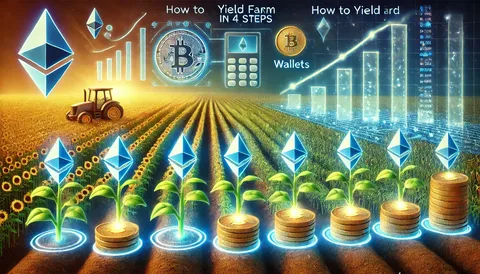The decentralized finance landscape has evolved dramatically, making it crucial to understand the best DeFi yield farming strategies 2025 has to offer. As traditional banking systems continue to offer minimal returns, savvy investors are turning to yield farming as a powerful method to generate passive income from their cryptocurrency holdings. This comprehensive guide will explore proven strategies, emerging platforms, and risk management techniques that can help you maximize your DeFi yields while navigating the complexities of this rapidly evolving space. Whether you’re a seasoned DeFi veteran or just starting your yield farming journey, implementing the right strategies in 2025 can significantly impact your portfolio’s performance and long-term success.
Understanding DeFi Yield Farming in 2025
DeFi yield farming has matured significantly since its inception, offering more sophisticated opportunities for investors seeking higher returns. The practice involves lending or staking cryptocurrency assets in decentralized protocols to earn rewards, typically in the form of additional tokens or interest payments.
The DeFi ecosystem in 2025 presents unique advantages over traditional finance. Unlike conventional banking products that offer minimal interest rates, DeFi protocols can provide annual percentage yields (APY) ranging from 5% to over 100%, depending on the strategy and market conditions. This dramatic difference stems from the elimination of intermediaries and the automated nature of smart contracts.
Modern yield farming encompasses various strategies including liquidity provision, staking, lending, and more complex approaches like leveraged farming. The key to success lies in understanding each method’s risk-reward profile and selecting strategies that align with your investment goals and risk tolerance.
The regulatory landscape has also evolved, with clearer guidelines emerging in many jurisdictions. This regulatory clarity has attracted institutional investors and improved the overall legitimacy of DeFi yield farming, leading to more stable and mature protocols.
Best DeFi Yield Farming Strategies 2025: Top Approaches
Single-Asset Staking Strategies
Single-asset staking represents one of the most straightforward approaches to yield farming. This strategy involves depositing a single cryptocurrency into a staking pool to earn rewards without the complexity of managing multiple assets or dealing with impermanent loss.
Popular single-asset staking options include Ethereum 2.0 staking, which offers approximately 4-6% APY, and various proof-of-stake tokens like Cardano, Solana, and Polkadot. The beauty of single-asset staking lies in its simplicity and predictable returns, making it ideal for conservative investors or those new to DeFi.
When implementing single-asset staking strategies, consider the lock-up periods, validator requirements, and slashing risks associated with different networks. Some protocols offer liquid staking solutions that provide staking tokens, allowing you to maintain liquidity while earning staking rewards.
Liquidity Provision and LP Farming
Liquidity provision involves supplying two assets to a decentralized exchange (DEX) liquidity pool in exchange for LP (liquidity provider) tokens. These LP tokens can then be staked in farming pools to earn additional rewards, creating a dual income stream.
Automated Market Maker (AMM) protocols like Uniswap, SushiSwap, and PancakeSwap offer numerous LP farming opportunities. The key is selecting pairs with high trading volumes and favorable reward structures while managing impermanent loss risk.
Consider providing liquidity to stablecoin pairs like USDC-USDT or ETH-USDC to minimize impermanent loss while still earning substantial yields. Many protocols also offer bonus rewards for providing liquidity to newer or less liquid pairs, though these come with higher risks.
Leveraged Yield Farming
Leveraged yield farming amplifies potential returns by borrowing additional capital to increase your farming position. Platforms like Alpha Homora, Lever, and Gearbox Protocol enable users to farm with borrowed funds, potentially multiplying returns.
This strategy involves borrowing assets at one interest rate and farming them at a higher yield, capturing the difference as profit. However, leveraged farming significantly increases risk, including liquidation risk if asset prices move unfavorably.
Successful leveraged farming requires careful position management, monitoring of liquidation levels, and understanding of the underlying protocols’ mechanics. It’s essential to maintain adequate collateral ratios and have exit strategies in place.
Risk Management in DeFi Yield Farming
Smart Contract Risk Mitigation
Smart contract vulnerabilities represent one of the primary risks in DeFi yield farming. To mitigate this risk, focus on protocols with established track records, comprehensive audits, and substantial total value locked (TVL).
Research the protocol’s audit history, bug bounty programs, and security measures. Protocols audited by reputable firms like ConsenSys Diligence, Trail of Bits, or OpenZeppelin generally offer higher security assurance.
Diversification across multiple protocols reduces the impact of any single smart contract failure. Avoid concentrating all funds in one protocol, regardless of how attractive the yields appear.
Impermanent Loss Protection
Impermanent loss occurs when the price ratio of assets in a liquidity pool changes compared to when you first deposited them. Several strategies can help minimize this risk while maintaining yield farming opportunities.
Choose correlated pairs or stablecoin pairs to reduce impermanent loss exposure. Some protocols like Bancor and Thorchain offer impermanent loss protection features, compensating LPs for losses under certain conditions.
Monitor your positions regularly and consider rebalancing when significant price divergences occur. Automated portfolio management tools can help maintain optimal allocations and reduce manual oversight requirements.
Protocol and Platform Selection
Selecting reliable protocols forms the foundation of successful yield farming. Focus on protocols with strong fundamentals, active development teams, and robust governance structures.
Evaluate protocols based on TVL, trading volume, token distribution, and community engagement. Established protocols like Aave, Compound, and Curve generally offer more stability, while newer protocols may provide higher yields but carry additional risks.
Consider the protocol’s token economics and governance structure. Well-designed tokenomics with clear utility and sustainable reward mechanisms indicate long-term viability.
Top DeFi Platforms for Yield Farming in 2025
Established Platforms with Proven Track Records
Aave continues to dominate the lending space, offering competitive yields for both lenders and borrowers. The protocol’s safety module and diverse asset support make it attractive for conservative yield farming strategies.
Compound Protocol remains a cornerstone of DeFi lending, providing transparent and audited smart contracts for yield generation. The protocol’s governance token (COMP) adds additional earning potential through liquidity mining programs.
Curve Finance specializes in stablecoin trading and offers some of the highest yields for stablecoin liquidity providers. The protocol’s vote-escrowed tokenomics (veCRV) create long-term incentive alignment for participants.
Emerging High-Yield Opportunities
Layer 2 protocols like Polygon, Arbitrum, and Optimism offer significantly lower transaction costs, making smaller farming positions economically viable. Many established protocols have deployed on these networks with attractive incentive programs.
Cross-chain protocols like Thorchain and AnySwap enable yield farming across multiple blockchains, accessing opportunities previously limited to specific networks. These protocols often offer higher yields due to their novelty and additional complexity.
Yield aggregators like Yearn Finance and Harvest Finance automatically optimize farming strategies, moving funds between protocols to maximize returns while minimizing gas costs and manual oversight.
Specialized Yield Farming Protocols
Olympus DAO introduced the concept of protocol-owned liquidity and (3,3) game theory, creating unique staking opportunities with potential for high returns. However, these protocols require careful understanding of their tokenomics and sustainability models.
Convex Finance leverages Curve’s governance tokens to boost yields for Curve liquidity providers, creating a specialized ecosystem around CRV rewards optimization.
Concentrated liquidity protocols like Uniswap V3 allow for more capital-efficient liquidity provision, potentially increasing yields for active liquidity managers willing to actively manage their positions.
Advanced Strategies for Maximizing Returns

Yield Farming Automation
Automated yield farming through protocols like Yearn Finance, Beefy Finance, and Harvest Finance removes the complexity of constantly monitoring and optimizing positions. These platforms automatically compound rewards and rebalance positions for optimal returns.
Consider using yield farming bots or services that automatically claim rewards, compound earnings, and migrate funds between protocols based on changing market conditions. However, ensure these services are reputable and understand their fee structures.
Dollar-cost averaging into yield farming positions can help smooth out volatility and reduce timing risk. Regular investments into proven farming strategies can build substantial positions over time.
Multi-Chain Yield Farming
Diversifying across multiple blockchains provides access to different yield opportunities and reduces dependency on any single network. Consider farming on Ethereum, Binance Smart Chain, Polygon, Avalanche, and other established networks.
Cross-chain bridges enable moving assets between networks to capitalize on yield differentials. However, bridge risks and transaction costs must be factored into the overall strategy profitability.
Monitor gas fees and network congestion across different chains to optimize timing for position entries and exits. Layer 2 solutions often provide similar yields with significantly lower transaction costs.
Risk-Adjusted Portfolio Construction
Construct diversified yield farming portfolios by allocating capital across different risk levels and strategies. A balanced approach might include 40% low-risk stablecoin farming, 40% medium-risk LP farming, and 20% high-risk leveraged or experimental protocols.
Regularly rebalance portfolios based on changing market conditions and yield opportunities. Set target allocations and rebalance when positions deviate significantly from targets.
Implement stop-loss and position sizing rules to limit downside risk. Never invest more than you can afford to lose, and always maintain emergency liquidity outside of DeFi protocols.
Tools and Resources for Yield Farmers
Essential Analytics and Monitoring Tools
DeFiPulse and DefiLlama provide comprehensive analytics on DeFi protocols, including TVL, yields, and security metrics. These platforms offer crucial data for making informed farming decisions.
Yield farming calculators help estimate returns and compare different strategies. Tools like APY.vision and DeBank provide portfolio tracking and impermanent loss calculations for active positions.
Gas trackers like ETH Gas Station and DeFi Saver’s gas price oracle help optimize transaction timing to minimize costs and maximize net returns.
Portfolio Management Solutions
Zapper and Zerion offer comprehensive DeFi portfolio management, allowing users to view all positions across multiple protocols and chains in a single interface.
Tax reporting tools like Koinly and TokenTax help track DeFi activities for tax compliance, automatically calculating gains, losses, and income from farming activities.
Risk management tools like DeFi Saver’s automation features can automatically protect positions from liquidation or rebalance portfolios based on predefined rules.
Common Mistakes to Avoid in Yield Farming

Overexposure to High-Risk Protocols
Chasing extremely high yields often leads to exposure to untested or high-risk protocols. While 1000%+ APY might seem attractive, these yields are often unsustainable and come with significant smart contract risks.
DYOR (Do Your Own Research) principles apply strongly to DeFi. Understand the protocol mechanics, tokenomics, and team background before committing significant capital.
Avoid FOMO-driven decisions and maintain disciplined allocation strategies. High yields often compensate for high risks, and understanding this relationship is crucial for long-term success.
Ignoring Gas Costs and Fees
High Ethereum gas fees can quickly erode yields, especially for smaller positions. Calculate net returns after accounting for transaction costs, including deposits, withdrawals, and reward claiming.
Consider batching transactions during low-gas periods or using Layer 2 solutions to reduce costs. Some protocols offer gas rebates or subsidies that can improve overall profitability.
Factor in all costs including DEX trading fees, bridge fees for cross-chain movements, and potential slippage costs when entering and exiting positions.
Lack of Diversification
Concentrating all farming activities in a single protocol or strategy creates unnecessary risk concentration. Diversification across protocols, strategies, and chains helps protect against individual protocol failures.
Avoid putting all funds into the highest-yielding opportunity without considering the associated risks. A diversified approach often provides better risk-adjusted returns over time.
Balance between established, lower-yield protocols and newer, higher-yield opportunities to optimize the risk-return profile of your overall portfolio.
Future Outlook for DeFi Yield Farming
The DeFi yield farming landscape continues evolving with new innovations like real-world asset tokenization, cross-chain infrastructure improvements, and institutional adoption driving growth. Regulatory clarity will likely improve, attracting more traditional investors and increasing overall market stability.
Layer 2 scaling solutions and alternative blockchain networks are making yield farming more accessible by reducing transaction costs. This democratization of DeFi access will likely expand the user base and total value locked in protocols.
Integration with traditional finance through central bank digital currencies (CBDCs) and regulated stablecoin issuers may create new yield farming opportunities while providing additional legitimacy to the space.
Conclusion
Implementing the best DeFi yield farming strategies 2025 requires a balanced approach combining thorough research, risk management, and strategic diversification. The opportunities in decentralized finance continue expanding, offering unprecedented access to high-yield investment strategies previously available only to institutional investors.
Success in yield farming demands continuous learning and adaptation as the DeFi landscape evolves rapidly. Start with conservative strategies like single-asset staking or stablecoin farming, then gradually explore more complex opportunities as your understanding deepens.
Remember that higher yields typically come with increased risks, and sustainable returns require patience and disciplined approach rather than chasing short-term opportunities. The most successful yield farmers focus on risk-adjusted returns rather than maximum yields.
Ready to start your yield farming journey? Begin by researching the protocols mentioned in this guide, starting with small positions to gain experience, and gradually building your DeFi portfolio using these proven best DeFi yield farming strategies 2025. Always invest responsibly and never risk more than you can afford to lose.

















